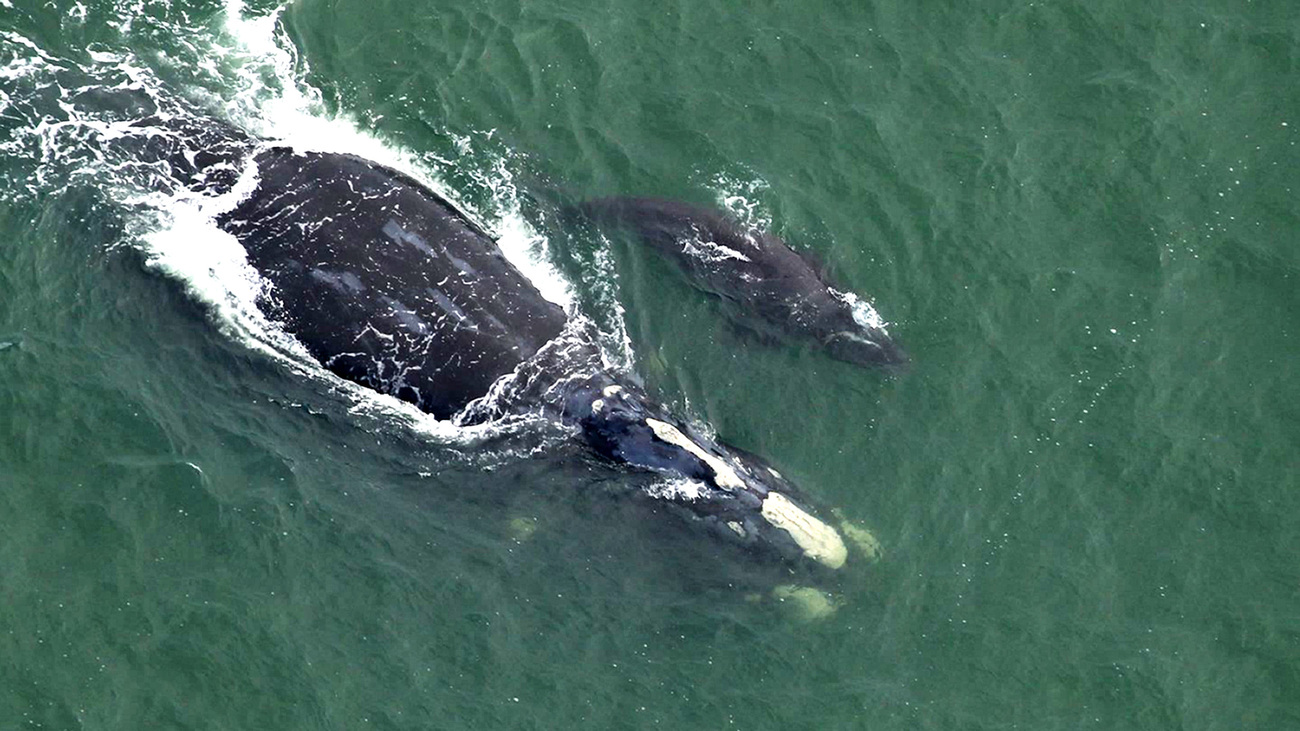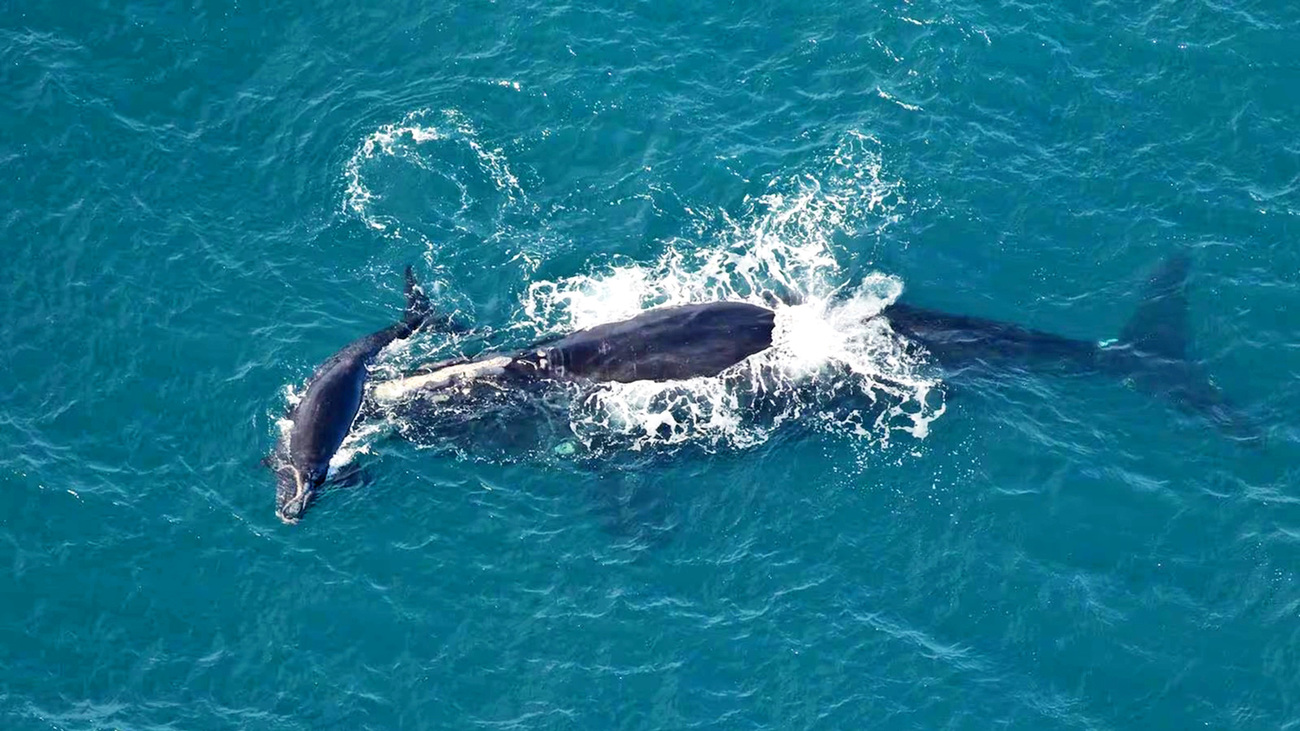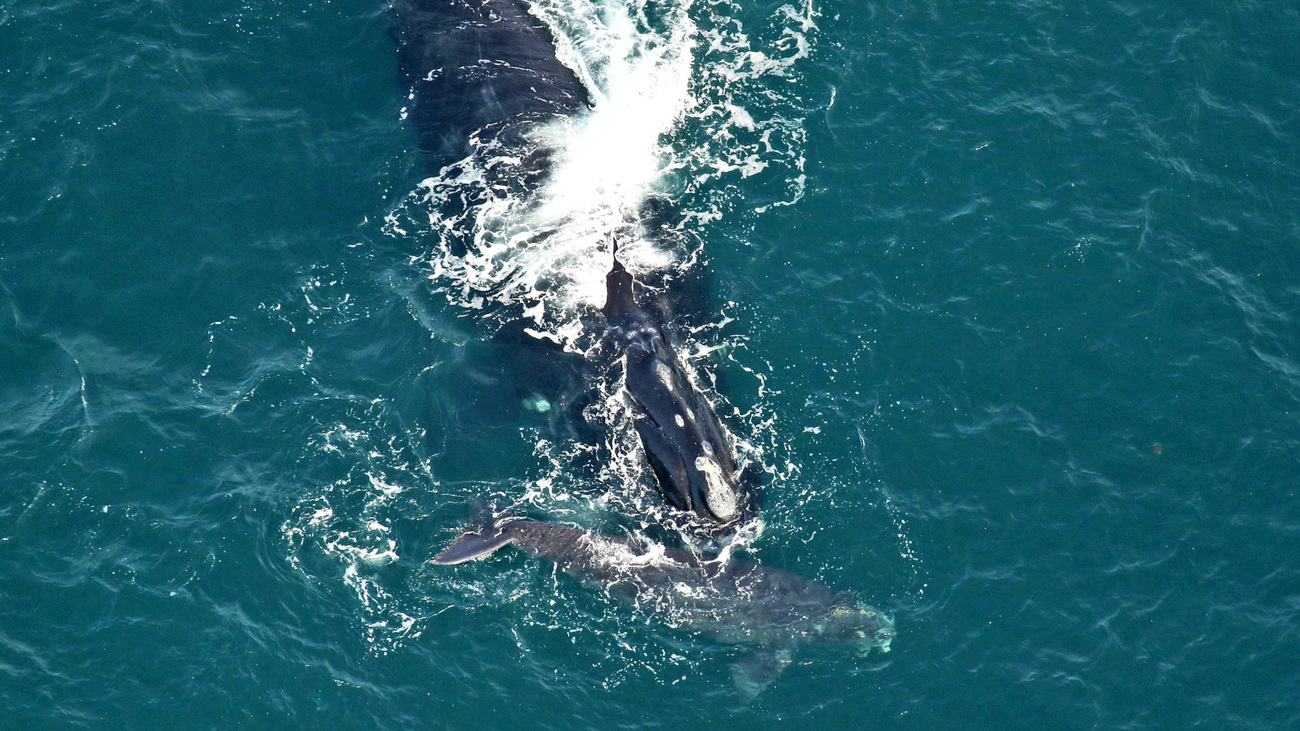Saving the North Atlantic right whale - North America
Don't fail our whaleCelebrating the births of North Atlantic right whales in 2024
Celebrating the births of North Atlantic right whales in 2024
For a species on the brink of extinction, every single birth is a cause for hope, and every death is a reason for us to work harder to protect them. That’s certainly the case for North Atlantic right whales.
With only about 370 of these magnificent whales left, around 50 calves must be born each year to stabilize the population. Fewer than 20 a year for several years would lead to extinction. In the 2024 calving season (November 2023 to April 2024), 20 new calves were spotted. One of those was large enough that researchers know it wasn’t born this season but hadn’t previously been identified. That makes 19 documented births this season—the second highest birthrate of the past decade.
Sadly, the season’s story does not end there. Five of those 19 calves either died or are presumed to have died, because their mothers were seen without them before they could survive on their own. One of this year’s mothers also died. The main causes of death are vessel strikes (injuries from colliding with ships) and entanglement in fishing ropes and other gear.
This is an overview of the 2024 calving season. Updates on the current North Atlantic right whale calving season can be found here.
1. Calf of Juno (Catalog #1612)

Spotted on November 28, 2023, by the Florida Fish and Wildlife Research Institute near the entrance to Winyah Bay in South Carolina, Juno’s calf appeared no more than four days old. Juno is at least 38 years old, and this is her eighth documented calf. Her last calf was born four years ago.
Sadly, on January 3, 2024, the calf was seen with several propeller wounds on the head, mouth, and left lip, consistent with a vessel strike—the first calf spotted this season was also the first known to be injured. The wounds were too significant to survive.
On March 2, 2024, Juno was seen without her calf near St. Augustine, Florida. The following day, the calf’s body washed ashore on Cumberland Island National Seashore, Georgia. This calf’s death at only four months old serves as a reminder that it is now more important than ever to reduce vessel speeds to avoid collisions with these whales.
2. Calf of Horton (Catalog #3360)
Horton (Catalog #3360) was seen with a new calf on December 7, 2023, near St. Catherine’s Island, Georgia, by Clearwater Aquarium. Horton is more than 21 years old, and this is her third known calf. Sadly, she lost her previous two, who were both seen either entangled in fishing gear or with injuries that suggested they had been entangled. That’s why we research ways to free whales from fishing gear and advocate for whale-safe fishing gear.
3. Calf of Palmetto (Catalog #1970)
The third calf of the season was spotted on December 8-9 near Port Royal Sound in South Carolina. This is the sixth calf of Catalog #1970, known as Palmetto, who is at least 35 years old. The pair was reported by a boater and the US Coast Guard Atlantic Area Command.
4. Calf of Wolf (Catalog #1703)
The fourth calf of the season, born to Catalog #1703, was spotted on December 22. The pair was seen off Atlantic Beach, near Jacksonville, Florida. Also known as Wolf, Catalog #1703 is 37 years old and has now given birth to five calves that we know of. Sadly, all her previous calves have either been injured or are dead or presumed dead.
Wolf’s last birth was nine years ago, while the typical interval between births for North Atlantic right whales should be about three years. Sadly, due to stressors like entanglement, these whales have not been reproducing as often as they have previously.
5. Calf of Braces (Catalog #3320)

Braces (Catalog #3320) has given birth to the fifth calf of the season. The two were spotted together on December 23 near Nassau Sound, Florida. This is the third calf of Braces, who is at least 26 years old. Her first calf hasn’t been seen since 2022, when he had entanglement injuries (as does Braces). She had her second calf only two years ago, which sadly signals that it likely died—after a year of pregnancy, a right whale mother needs at least one year of recovery and a year of raising her calf.
But the gap between her first two calves was much longer—13 years. Due to stressors in their environment, right whale mothers are not giving birth as often as they should be on average.
6. Calf of Halo (Catalog #3546)
The sixth calf of the season was spotted with Catalog #3546, known as Halo, on December 28. The pair was spotted east of Cumberland Island, Georgia. This is Halo’s third documented calf. Her second calf, born in 2020, hasn’t been seen since 2022. At 19 years old, Halo is one of the youngest mothers this season.
7. Calf of Catalog #3780
A 17-year-old right whale, Catalog #3780, was seen on December 31 with the seventh calf of the season. She was spotted alongside another mother, Legato (Catalog #1802), who also has a new calf. They were seen together near Amelia Island, Florida.
This is the first calf of Catalog #3780, who is one of the youngest mothers this year. At the time it was observed, the calf was fewer than three days old. Unfortunately, less than a week later, Catalog #3780 was seen without her calf, and it is presumed dead.
8. Calf of Legato (Catalog #1802)
Alongside Catalog #3780 and her calf, 36-year-old mother Legato was spotted with a newborn near Amelia Island, Florida, on December 31. This is Legato’s fifth calf on record. As her last calf was born 13 years ago, she serves as an example of how threats in their habitat—like entanglement—are affecting the speed at which North Atlantic right whales reproduce. A healthy right whale in a stress-free environment should be able to have a new calf every three years.
9. Calf of Swerve (Catalog #1810)
The ninth calf of the season—and the first of the new year—was spotted on January 3 off Altamaha Sound, Georgia. Its mother is Catalog #1810, known as Swerve, who has six recorded calves. Swerve is also a grandmother—she has two recorded grand-calves.
Swerve has been entangled in fishing gear twice in her life, and her last calf was born eight years ago. While it’s incredible that she has been able to survive two entanglements and persevere to be a mother and grandmother, many North Atlantic right whales are not so lucky. Entanglement is a stressor that can cause longer periods between births for right whale mothers—and they need all the new calves they can get to replenish their population.
10. Calf of Catalog #1950

Right whale Catalog #1950 was seen with the 10th calf of the season near St. Simons Island, Georgia. This was the mother’s sixth calf and the first time she had given birth in nine years. She was at least 36 years old.
Tragically, on March 30, 2024, Catalog #1950 was found dead, floating approximately 50 miles east of Back Bay National Wildlife Refuge in Virginia. A necropsy showed she had a dislocated spine and fractures to all the vertebrae in her lower back. Her calf was not spotted but was too young to survive without its mother.
11. Calf of Limulus (Catalog #2912)
The 11th calf of the season was spotted with Limulus (Catalog #2912) near Ossabaw Island, Georgia. Limulus last gave birth 11 years ago, and this is her third calf. She’s 25 years old.
12. Calf of Fenway (Catalog #2791)
Fenway (Catalog #2791) is the mother of this season’s 12th calf. The pair was spotted near Cumberland Island, Georgia. This is Fenway’s fourth calf, and she’s at least 28 years old. She last gave birth five years ago.
13. Calf of Half Note (Catalog #1301)
The 13th calf of the season was spotted with mother Half Note (Catalog #1301) near Cumberland Island, Georgia. Unfortunately, this calf appeared underweight and unhealthy, and survey teams spotted Half Note without the calf three days later.
Half Note is 41 years old, and this was her eighth calf. Sadly, Half Note has lost seven calves, including this one.
14. Calf of Marilyn Monroe (Catalog #3130)

The North Atlantic right whale dubbed Marilyn Monroe (Catalog #3130) and her new calf were spotted on January 17, 2024, near Jekyll Island, Georgia. This is her fourth calf, and she last gave birth three years ago. She’s 23 years old.
15. Calf of Catalog #3820
The 15th right whale calf of the season was spotted off Nassau Sound in Florida on January 24, 2024. The mother is Catalog #3820, who is 16 years old—this was her first calf. Four calves were born to new mothers this season; the other first-timers were Catalog #3780 and Catalog #3725, who are both 17 years old, and Catalog #3590, who is 19.
Most female North Atlantic right whales start giving birth to calves at around eight to 12 years old. Stress from factors like vessel strikes and entanglement can affect the health of these whales and delay calving.
16. Calf of Butterfly (Catalog #1425)
A new calf was spotted with Butterfly (Catalog #1425) near Ponte Vedra Beach, Florida, on January 27. This was Butterfly’s fifth calf, and she’s at least 43 years old. Previously, she hadn’t given birth since the 2014 season—one decade ago. She also became a grandmother as her daughter, Catalog #3725, gave birth to the 17th calf of the season.
17. Calf of Catalog #3725
A 17-year-old right whale, Catalog #3725, was seen with a new calf on January 30, 2024, near Ponte Vedra Beach, Florida. This is her first calf. She was the 17th right whale to give birth this season, and there were 17 other breeding-age female whales observed in the area that weren’t seen with calves—but they are all potential mothers, and every new right whale matters in the uphill battle to save this species.
18. Calf of Skittle (Catalog #3260)
A female North Atlantic right whale nicknamed Skittle (Catalog #3260) was spotted with a new calf near Kure Beach, North Carolina, on February 16, 2024. Skittle is at least 22 years old, and this is her second known calf. Sadly, Skittle was seen in March and April without her calf, so it is presumed dead.
19. Calf of Dog-ear (Catalog #3590)
Another right whale mother, nicknamed Dog-ear (Catalog #3590), was seen with a newborn calf off the coast of Cape Canaveral, Florida, on February 16, 2024. Dog-ear was born in 2005, making her about 19 years old. This is her first known calf.
Related content
every problem has a solution, every solution needs support.
The problems we face are urgent, complicated, and resistant to change. Real solutions demand creativity, hard work, and involvement from people like you.